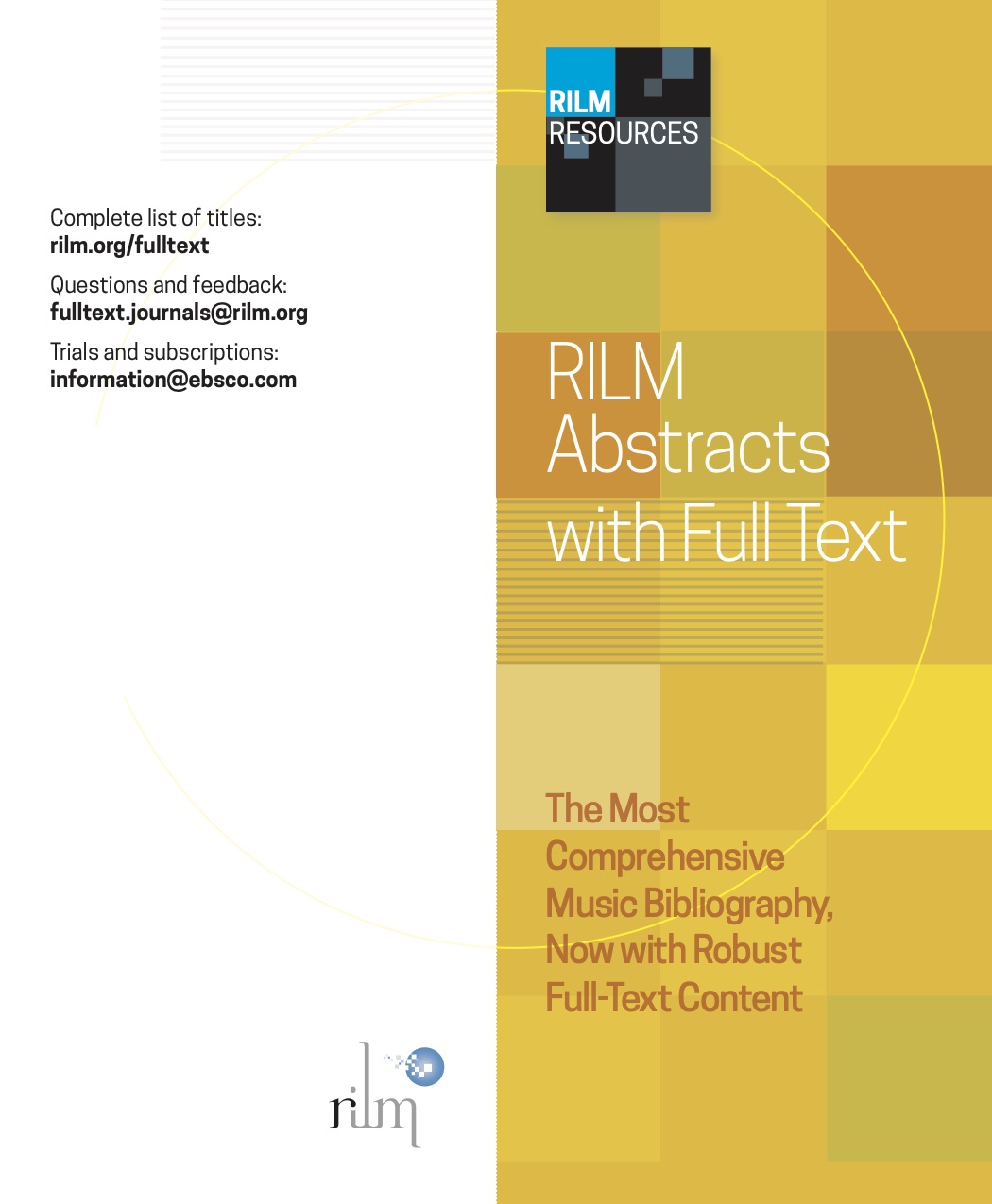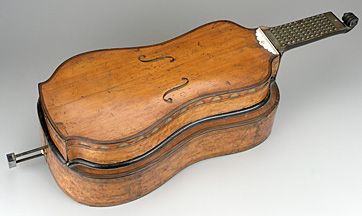These guidelines describe the types of source documents appropriate for inclusion in RILM Abstracts—referred to in these guidelines as “RILM material”.
RILM material falls into two broad categories: (1) writings and other resources that provide an analysis, show the results of systematic research, or give a critical opinion or interpretation; (2) writings and other resources that provide important source material (including but not limited to correspondence, interviews, obituaries, conference reports, criticism, and biographies). RILM material can be published in any format.
Many musical fields rely on publications that are traditionally scholarly in nature, while others—especially those related to current musical life—have come to rely on a broader range of publications for much of their source material. Inclusion decisions should take this into account, bearing in mind that publications relied upon by music scholars are appropriate for inclusion in RILM Abstracts.
Document types of RILM material
RILM Abstracts includes all writings and resources likely to be of value to music researchers, whether printed, digital, or in any other format. The first priority is to cover the most important and scholarly items from all subject areas. While RILM material appears in different publication types from one country to the next, in general, priority will be given to core journal articles, monographs, essay collections, conference proceedings, Festschriften, dissertations, and theses.
Periodical coverage
All periodical articles on music and related disciplines are considered to be RILM material. Given the vastness and variation of this literature, the following coverage priorities have been established. The first three categories (core, secondary, and tertiary) pertain specifically to music journals and represent a descending order of priority.
Core journals: These are flagship journals of music studies; all articles are abstracted and all book reviews are cited (film and sound recording reviews are cited at the discretion of RILM editors). Core status is assigned to journals by the national committees, which thereby commit to fully abstracting them and in a timely manner. The RILM International Center may also assign core status to a journal, particularly (but not exclusively) for journals published in countries with no national committee; in such cases, staff editors at the Center abstract the journal. The International Center may also remove the core status of a journal if it is not being covered consistently. All core journal issues should be available to staff editors at the International Center.
Secondary journals: These are also deemed significant for music studies. They are systematically scanned for articles that fall within RILM’s scope guidelines, and these articles are abstracted. Secondary status is assigned primarily by national committees, which thereby commit to scanning each issue, upon publication, for RILM content, and abstracting that content. The International Center may also assign secondary status, or, if a title is not being systematically scanned and abstracted, it may remove secondary status. Wherever possible, secondary journal issues should be available to staff editors at the International Center.
Tertiary journals: These are less oriented toward music scholarship. They are not systematically scanned, and their contents are abstracted selectively.
Other disciplines: Articles on music from multi-disciplinary and other non-music journals are also entered into the database by the national committees, authors, and RILM International Center staff.
The four categories described above are for periodical articles in any media. If the article is part of an electronic journal or website, the following criteria must be met: (1) there is a procedure in place for archiving the journal or site; (2) there is an editorial policy in place; (3) the journal is published regularly; (4) the journal has a publisher (that is, it is not self- or editor-published).
An abstract for an entire issue of a periodical is to be sent to the International Center if it is a special issue devoted to a particular topic and is designated as a “thematic” issue in its title or on its title page or spine.
Publishers are invited to submit their periodicals to RILM International Center in order to have their content included in RILM abstracts.
Collections (Festschriften, conference proceedings, collections of essays)
RILM material includes collections of essays, Festschriften, and conference proceedings. For such collections, a citation (with or without abstract) must be provided for the collection as a whole (a cover record), and each individual article must also receive a citation and an abstract (analytic records). National committees must strive to include a record for every article when the collection is entirely devoted to music, ensuring the inclusion of complete collections in RILM Abstracts. In cases where only some of the articles pertain to music, a cover record for the collection is required, as well as individual citations and (where possible) abstracts for each music-related item only. Collections of articles by a single author should include an abstract for each article separately.
Monographs and other books
Besides original monographs, RILM material includes facsimiles of literature on music (reproductions of early printed editions or manuscripts), reprints, new or revised editions, translations, and catalogues of exhibitions.
Dissertations and theses
RILM material includes doctoral level (or highest postgraduate degree level) dissertations in music and in other disciplines when they concern music. Master’s level or other student theses are included when they contain significant new information or a new interpretation, and are publicly available.
Electronic resources
RILM material includes electronic resources that are of value to researchers, including, but not limited to, websites, blogs, podcasts, databases, CD-ROMs, and other media.
Reviews
RILM includes reviews of any material that falls within its scope. In general, reviews that describe or critically assess a given publication are included; those that merely mention a publication’s existence are not. All reviews listed in core and secondary journals should be included without exception.
Technical drawings of historical instruments
Special caution is to be applied in reviewing the following kinds of materials for inclusion in RILM Abstracts:
- Editions of music (including facsimiles) should be entered only when they include substantial written material (scholarly apparatus, source studies, notes on performance).
- Articles from daily newspapers and magazines only when they offer important information not available elsewhere, such as obituaries, or are major critical articles that include results of original research.
- Program notes, pamphlets, brochures, and other small separate publications only if they are of particular importance to music researchers and are publicly available.
- Sound and video recordings only when one or more of the following criteria are met: (1) when the recording or film is important source material for ethnomusicological, popular, or performance studies; (2) when the recording is accompanied by substantial written material; or (3) when the recording or film is the subject of a review.
- Feature films that claim biographical authority should be included.
- Reviews of concerts only when the review itself can be considered RILM material and is therefore of particular importance to music researchers.
RILM Abstracts excludes writings unlikely to be of value to music researchers, including the following:
- Practical manuals and “how-to” books, unless they are modern editions of important historic texts, have received substantial reviews, or are otherwise of particular value to music researchers.
- Rudimentary instructional manuals, with the same exceptions as above.
- Outlines for classroom use. Reviews that are merely publication announcements.
Subject categories of RILM material
RILM Abstracts includes writings and other resources on music and related disciplines, including the following:
- Historical musicology
- Ethnomusicology, including reviews of sound and video recordings in RILM core periodicals
- Popular music and jazz
- Theory, analysis, and composition
- Sound sources, instruments, their techniques, reprints of historical teaching methods and treatises, makers, technical drawings of historical instruments.
- Performance practice and notation
- Pedagogy
- Reference and research materials, including catalogues of temporary exhibitions and permanent museum collections, discographies, directories, encyclopedias, bibliographies, composers’ work lists issued by music publishers, and library catalogues. Research material available on websites should be included.
- Music and other arts, including but not limited to dance, dramatic arts, poetry and literature (including novels about composers written with biographical authority, if reviewed in a music periodical covered in RILM abstracts), items on music iconography, and music and art
- Music and related disciplines, including but not limited to philosophy, aesthetics, criticism, psychology, hearing, perception, physiology, therapy, medicine, archaeology, anthropology, engineering, sound recording, acoustics, architecture, computers, sociology, linguistics, semiotics, printing, engraving, publishing, economics, copyright, and other legal matters
- Music in liturgy and ritual











































